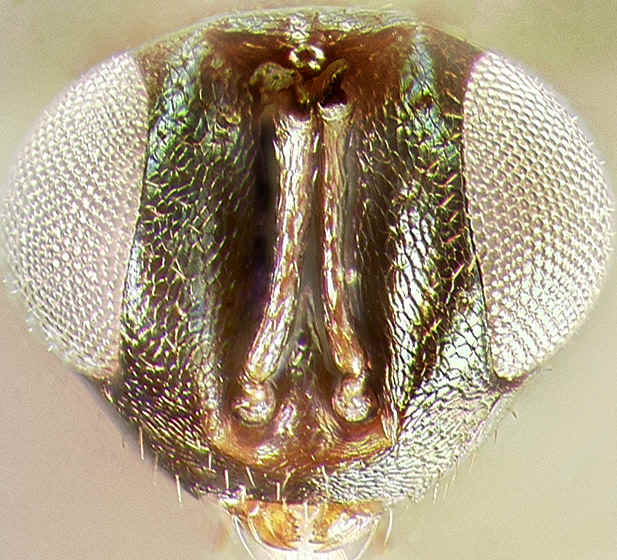1a-b: Necremnus capitatus Boucek female (left), and N. propodealis Boucek female (right)
return to: Eul 1 Eul 4 ent 1 eud 1 cir1 eul 1 eul 5 eul 10 eul 14 eul 17 eul 20 eul 24 eul 27
Necremnus
Thomson, 1878 comparative info return to: prev home
Mandibles capable of meeting medially, not reduced. Flagellar formula 1,3,3 in females,
1,3,3 or 1,4,2 in males; basal 3 funicular segments with long branches in males, 1st
funicular segment at least slightly longer than pedicel in males. Notauli incomplete;
scutellum quadrate or longer than broad, without submedian or sublateral grooves.
Postmarginal vein at most 1.7x stigmal vein length; uncus rarely arising more than its own
length from pigmented apex of stigmal vein [known exceptions: N. metalarus (Walker)].
Propodeum with a median carina, that is frequently reduced and incomplete; with or without
plicae, some species with 'step-like' plicae that separate raised median panels from
sunken paraspiracular area; costula absent. 1st mesotarsal segment longer than 2nd.
Compare with: Microlycus, Eulophus, Dahlbominus,
Sympiesis.
1a-b: Necremnus capitatus Boucek female (left), and N.
propodealis Boucek female (right)

2a-b: Necremnus face (left), and N. leucarthros (Nees)
male antenna (right)
Biology: Parasitoids of Lepidoptera, Coleoptera.
Comments: Large genus with certain species similar to a number of other genera. Forms the central part of a group including Eulophus, Dicladocerus, Microlycus, and perhaps Dahlbominus. This is a very poorly known and poorly defined genus, approaching the aforementioned genera and some others that may not be closely related to it. Females cannot be fully separated from those of Dicladocerus.
Comparative information:
Microlycus: Body short and stout: 0.9-1.9mm in length. Scape length subequal distance between lateral ocelli; lateral ocelli near eye margin; apical pair of funicular segments subquadrate to much broader than long in females. Scutellum distinctly broader than long. Very difficult to distinguish except by using vague differences in proportion of the scape, flagellomeres and scutellum.
Dicladocerus: Males with 2 antennal branches. Most males and females with strong parallel submedian scutellar grooves. All female Dicladocerus that I am aware of with faint submedian scutellar grooves have plicae or plical ridges delimiting median panels that are slightly to sharply raised above the lateral areas of the propodeum, and in nearly all species of Dicladocerus the uncus is separated from the stigmal apex by more than its own length. Necremnus propodealis Boucek is notable as a species of Necremnus with a strong median carina and step-like plicae, but in that species the uncus is separated by its own length from the stigmal apex. This still leaves a few species of Dicladocerus in which females cannot be separated from Necremnus females. This problem is compounded by the fact that some Necremnus specimens have very faint submedian scutellar grooves. Separation of these two poorly known genera is problematic, and cannot be fully accomplished at this time.
Eulophus: Mandibles reduced, not capable of meeting medially. Basal mesotarsal segment (sometimes also basal metatarsal segment) shorter than 2nd segment, subequal or shorter than mesotibial spur. Body form strongly resembling Necremnus, but easily distinguished using the above characters.
Dahlbominus: Flagellum with 4 funicular segments in females; flagellum strongly compressed and broadening apically. Forewing disc almost always with large fuscate area posterior to marginal and postmarginal veins [lost in some specimens]. Scape, mesocoxa, and metacoxa usually light tan to white (sometimes brown, especially in males). This genus is remarkably similar to Necremnus in general form. Necremnus californicus (Girault) strongly resembles Dahlbominus in every way except scape and coxal coloration and flagellar formula of females. Males may be more difficult to distinguish, and species-level differences such as the coloration characters become very important at that point.
Sympiesis: Flagellum usually with 4 funicular segments, rarely 5 in males. Postmarginal vein about 2x stigmal vein length or longer. Median propodeal carina often absent, sometimes plicae present as diagonal carinae. Some species strongly resembling Necremnus, but easily distinguished by postmarginal vein length, flagellar formula of females, and with experience, by propodeal features.
References
Askew, R.R. 1968. Hymenoptera 2. Chalcidoidea section (b). Handbooks for the Identification of British Insects. 8(2)b.
Boucek, Z. 1959. A study of central European Eulophidae, 1: Eulophinae (Hymenoptera). Acta Entomologica Musei Nationalis Pragae. 33: 117-170.
Boucek, Z. 1974. On some European Eulophidae (Hymenoptera), with Descriptions of three new species. Acta entomologica Jugoslavica. 10(1-2): 117-123.
Graham, M.W.R. de V. 1959. Keys to the British genera and species of Elachertinae, Eulophinae, Entedoninae, and Euderinae (Hym., Chalcidoidea). Transactions of the Society for British Entomology. 13: 169-204.
Graham, M.W.R. de V. 1963. Additions and corrections to the British list of Eulophidae (Hym., Chalcidoidea). Transactions of the Society for British Entomology. 15(9): 167-275.
Schauff, M.E., J. LaSalle, & L.D. Coote. 1997. Chapter 10. Eulophidae. in "Annotated Keys to the Genera of Nearctic Chalcidoidea (Hymenoptera)". G.A.P. Gibson & J.T. Huber, eds. NRC Research Press, Ottawa.
Image credits: 1a-b: Boucek (1959). 2b: Graham (1963).